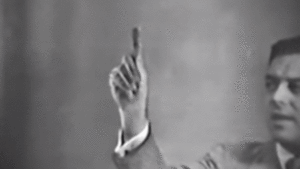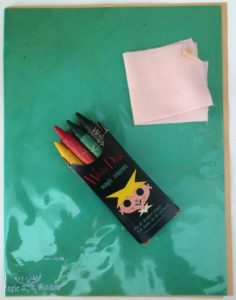
The elder members of the Boomer have once again spoken. Today’s I Remember JFK memory is all about Winky-Dink and You, praised by, among others, uber-geek Bill Gates as an interactive kid’s show that turned the television into the world’s first multimedia device.
Winky-Dink began airing at 9:30 central time on Saturday mornings in 1953. Televisions were rare enough then that kids would often gather at a home that had one to see the adventures of the little star-headed adventurer wearing the plaid pants who needed YOUR help to get out of various fixes.
Winky-Dink featured Jack barry as Winky’s narrator, who would prompt kids at home to put their plastic Winky-Dink screen over the front of the boob tube and draw whatever it was that the hero needed to formulate an escape from whatever fix he had found himself in. Of course, the mere lack of a screen wouldn’t stop imaginative children from drawing directly on the glass with whatever writing implement was handy. Thus did many a parent learn that a fifty-cent investment in a Winky-Dink screen kit would greatly extend the life of a much more expensive television set.

To say that Winky-Dink had a passionate following would be an understatement. There are a wealth of memories all over the web from grown-up kids who assisted W-D in escaping tight spots by drawing bridges to get over rivers, parachutes to gently lower him to the ground, or ladders to crawl out of deep holes.
The reason for these vivid recollections is simple: the act of drawing on the screen helped plant the moment deeply into the child’s permanent memory. TV was new enough that the youngsters involved likely remembered life without it, and now, this recently-obtained incredible talking moving picture machine was inviting them to become part of the show!
That’s powerful stuff.
The interaction also involved decoding messages. Example: Horizontal lines would appear on the screen. Barry would direct kids at home to trace them out with the soft Winky-Dink crayons included in the kit. Later in the show, vertical lines would be shown. Once the kid traced them out, a secret message would appear.
Now, I ask you: is there anything on this planet more cool than that to a seven-year old kid?
Afterwards, the plastic screen would be peeled off of the television and wiped clean. Static electricity made for a very powerful “magnet” that held the sheet in place. It was all perfect for an interactive television experience.
Mr. Bungle joined Jack Barry on the show each week. Dayton Allen played the hapless assistant who would inadvertently screw things up. Allen was a familiar “face” of 1950’s and 60’s children’s television, playing the puppet voices of Phineas T. Bluster and Flub-a-Dub on Howdy Doody, He also voiced Deputy Dawg, Fearless Fly, and those mischievous magpies known as Heckle and Jeckle.
Winky-Dink and You rode high until it was canceled in April 1957. Host Jack Barry had gotten quite busy with other projects, including hosting the soon-to-be-infamous quiz show Twenty-One. Thus ended chapter one of Winky-Dink.
Chapter two began in 1969, with a syndicated version of the show that once again caused kits for interaction to be sold in dime stores all over the nation. The five-minute show was a minor hit until 1973. This time, the cause of its demise was more obvious: concerns about radiation possibly emanating from now-common color televisions.
Today, you can still purchase Winky-Dink (the latter incarnation) on DVD, including the screen kit, at this site. It’s a cheap 25 dollar investment in planting some seriously great memories into the minds of your grandchildren.
And great memories are what life is all about, right?
I loved Winky Dink I was scooled for coloring on the screen couldn’t wait for my magic screen to come,I went on to become a artist ,Interior Designer ,color specialist for paint as paint manager ,I graduated from College